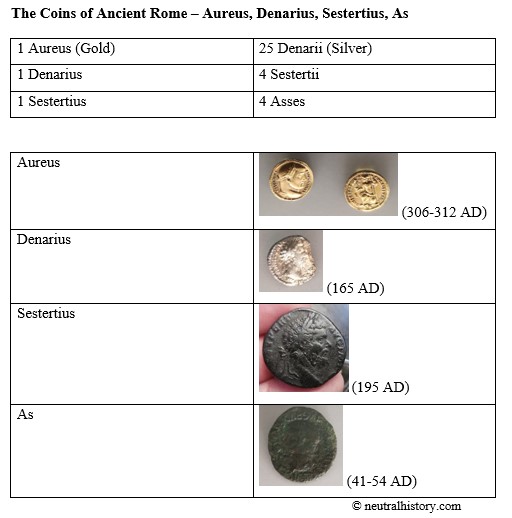When we think of ancient Rome then we usually think about the expansion of the Empire and the successful Roman army. And when we think about the city of Rome, then we usually imagine splendid buildings. But the daily life of the Romans is usually not at the top of our thoughts.
So in this article, I would like to give an overview of the prices of daily goods in ancient Rome and the wages that the average Roman could expect.
The Prices of Daily Goods in Ancient Rome
The following table will list the prices for daily goods in Rome but will not go into the price of slaves.
| Bread for 2 people (around 60 AD) | 1 As |
| Meat; Pork/ Beef (200-250 AD) | 2 Asses |
| Chickpeas (70-100 AD) | 1 As |
| Ginger; 1 lbs (1st century AD) | 6 Denarii |
| Black pepper; 1 lbs (1st century AD) | 4 Denarii |
| White pepper; 1 lbs (1st century AD) | 7 Denarii |
| Simple cup (early 2nd century AD) | 1 As |
| Terra Sigillata Plate (late 2nd century AD) | 1,2 Denarii |
| Decorated Terra Sigillate bowl (late 2nd century AD) | 2 Denarii |
| 2 silver beakers (1st century BC) | 25,000 Denarii |
| 1 barrel (mid-2nd century AD) | 7 Denarii |
| 1 used Toga (70-100 AD) | 3 Denarii |
| 1 pair of shoes (late 2nd century AD) | 2 Denarii |
| Pearl necklace (2nd / 3rd century AD) | 250,000 Denarii |
| 1 slave without special qualifications | 1,500 Denarii |
By the way.
Pepper was extremely popular in ancient Rome despite its relatively high price. Here you can find out more about how much pepper the Romans imported per year and how the pepper (and the other spices) were brought to Rome. Contrary to pepper, salt was pretty cheap and was used generously. But that`s a story for a different time.
Let`s now look at the salaries to learn more about the buying power of regular Romans.
Wages in Ancient Rome
The wages in Rome – just like today – varied drastically depending on the qualification of the worker.
| Auxiliary soldiers (1st / 2nd century AD) | ½ Denarius per day |
| Roman legionaries (1st century AD) | 1 Denarius per day |
| Praetorians (1st century AD) | 2 Denarii per day |
| Day laborer in a vineyard (25-50 AD) | 1 Denarius per day |
| Actor or Clown (2nd century AD) | 5 – 10 Denarii per day |
| Price for a prostitute (2nd century AD) | 5 Denarii per day |
| Doctor (pay of the famous Galen in 168 AD) | 10,000 Denarii (fee) |
| Lawyer (153 AD) | 500 Denarii (pay + travelcost) |
When we look at the table, then the pay of the Roman soldiers seems relatively low compared to the pay of unskilled workers. But it is important to remember, that Roman soldiers not only received regular pay but they would also receive a generous gift for their retirement after they had finished their military service.
The Roman currency system

FAQs
How much did a laborer make in ancient Rome?
A day laborer in the 1st century AD made 1 Denarius per day when he was working in a vineyard
How much did a Roman lawyer make?
A Roman lawyer in the year 153 AD made 500 Denarii for representing one client in court. That includes both his fee and compensation for his travel costs.
How much did a doctor make in ancient Rome?
In 168 AD the famous doctor Galen got an Honorarium of 10,000 Denarii for his services.
By the way, Galen was also the doctor of one of the Roman gladiator schools. There he could study the effects of the different weapons without the need to travel to distant battlefields.
How much did a toga cost in ancient Rome?
Between the years of 70 and 100 Ad a used toga did cost 3 Denarii. For comparison, a day laborer made 1 Denarius per day.
How much did bread cost in ancient Rome?
Bread for two people did cost 1 As in the first century AD. For comparison, a day laborer made 16 As per day.
How much did shoes cost in ancient Rome?
A pair of normal shoes did cost 2 Denarii in the second century AD. For comparison, a day laborer in a vineyard made 1 Denarius per day.
I hope you enjoyed our trip into the daily lives of the ancient Romans. Here you can find out more about the diet of the Romans.
Take care of yourself because you deserve it. You really do.
Until next time
Yours truly
Luke Reitzer
Sources
Paul Erdkamp: The Cambridge companion to ancient Rome.*
Tsevi Ya`vets: Slaves and Slavery in ancient Rome.*
Disclaimer: This post contains affiliate links that are identifiable by the *. If you use these links to buy something we may earn a small commission without additional cost for you. Thanks.